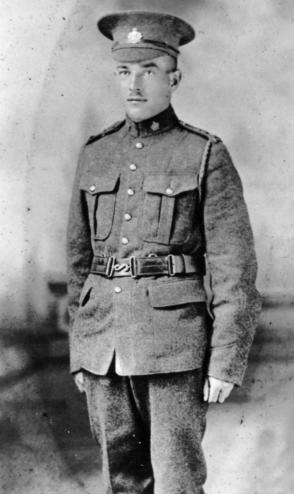
copyright © Wartime Heritage Association
Website hosting courtesy of Register.com - a web.com company
Wartime Heritage
ASSOCIATION
Remembering World War I
Yarmouth Connections

William Weed Gavel
Name:
Service No:
Rank:
Battalion/Service:
Date of Birth:
Place of Birth:
Date of Enlistment:
Place of Enlistment:
Address at Enlistment:
Age at Enlistment:
Height:
Complexion:
Eye Colour:
Hair Colour:
Previous Military:
Martial Status:
Trade:
Religion:
Next of Kin:
Date of Discharge:
Date of Death:
William Weed Gavel
734538
Private
112th Battalion; 25th Battalion
May 30, 1892
Richfield, Digby Co., NS
April 13, 1916
Yarmouth NS
23
5 feet 8 inches
light
blue
light brown
29th Battery, Canadian Field Artillery, Yarmouth NS (Recruit)
Single
Clerk
Baptist
Mrs Jane Gavel (Mother), Richfield, Digby Co., NS
Mrs. Ethel Gavel (Wife), West Jeddore, Halifax Co., NS (post attestation)
July 10, 1919 (Halifax; on demobilization)
April 7, 1959
William enlisted and trained in Canada with the 112th Battalion from enlistment until July, 1916. He
sailed from Halifax on the SS Olympic July 23, 1916, arriving in Liverpool, England on July 31, 1916. On
October 10, 1916 at Bramshott, he was transferred for overseas service in France with the 25th Battalion. He
arrived in France on October 11 and left the Canadian Base Depot for his Battalion on November 2. he joined
his unit in the field on November 5, 1917.
On December 17, 1916 he was admitted to No 5 Canadian Field Hospital with fever of unknown cause
(PUO, or Pyrexia Of Unknown Origin) later diagnosed as influenza. He rejoined his unit on January 2, 1917. He
was again admitted to No 6. Stationary Hospital at Frevent suffering from a wound and shell shock and was
discharged on March 8, 1917. On May 2, 1917 William received a slight gun shot wound to his left hand and
was admitted to No. 14 General Hospital at Wimereux and transferred to No. 1 Convalescent Hospital at
Boulogne (half-way house for wounded returning to the front - men who no longer required hospitalisation but
were not yet fit to rejoin their units). He was discharged on May 5 and returned to his unit.
On August 15, 1917 he received another gun shot wound to his left arm and was admitted to No. 18
General Hospital Dannes at Camiers. On August 25, he was transferred to No 1 Australian General Hospital at
Rouen and on August 29 to No. 2 Convalescent Hospital at Rouen. He was discharged to Base Details at Etaples
on September 21, 1917. On November 24, 1917 he rejoined the 25th Battalion in the field. He was granted
fourteen days leave in the UK on December 6, 1917 and rejoined his unit in France on December 24, 1917.
On April 23, 1918 while in the field he was again wounded in an accident (a severe incision below the left
knee) and admitted to No. 5 Canadian Field Ambulance. He was discharged on April 28, 1918 and returned to
the field. On August 26, 1918 he suffered a wound to his right arm and was admitted to No. 12 Stationary
Hospital at St. Pol and was transferred on August 30 by ambulance train to the 1st West General Hospital in
Liverpool, England where he remained until November 2, 1918 when he was transferred to the Military
Convalescent Hospital, Woodcote Park at Epsom. He was discharged from there on November 13, 1918. On
December 17, 1918 he was taken on strength with the 17th Reserve Battalion at Bramshott.
He returned to Canada embarking England at Liverpool on January 18, 1919 and disembarking at Halifax
on January 24, 1919.
On January 25, 1919 he was taken on strength at No. 6 District Depot Casualty Company, Halifax . On
March 10, 1919 William was promoted to Corporal (provisionally) and employed with the Administrative Staff of
Disp. Station “B”. On March 29, 1919 he was promoted to the rank of Sergeant (provisionally). On April 25 he
relinquished the rank on being posted to the Depot Casualty Company Administrative Staff at Halifax.
He was discharged from military service on July 10, 1919 (Halifax; on demobilization) having served in
Canada, England and France.

Sources:
Library and Archives Canada


- World War I - Menu
- WWI Stories and Articles
- Photos - Yarmouth Soldiers
- Selection of World War I Songs
- WWI Casualties of Yarmouth, NS
- Those Who Served - Yarmouth, NS
- WWI Casualties Digby Co. NS
- WWI Casualties Shelburne Co. NS
- Merchant Mariners (1915) Yarmouth, NS
- Canadian Forestry Corps - Non Yarmouth Birth/Residence Enlistments
- US Draft Registry - Yarmouth NS Born


- World War II - Menu
- WWII Stories and Articles
- Telegraphist Air Gunners
- WWII Casualties of Nova Scotia
- US Casualties with NS Connection
- Far East/Pacific Casualties with NS Connection
- Merchant Navy Casualties Nova Scotia
- Nova Scotia WWII Casualties Holten Canadian War Cemetery
- D-Day Casualties - Nova Scotia
- CANLOAN Program Casualties - Nova Scotia
- Battle of the Bulge Casualties - Nova Scotia
- WWII Casualties Yarmouth NS
- Yarmouth Casualties - RCAF RAF Canadian Army WWII
- Yarmouth Co., Marriages WWII
- Casualties Non-Born/Residents with Connection to Yarmouth Co., Nova Scotia.
- WWII Casualties Digby Co., NS
- Non-Nova Scotian WWII Casualties Buried in Nova Scotia
- WWII RCAF Casualties Aged 16-18
- Brothers/Sisters Who Served - World War II













